An Oval Cut diamond is a Fancy shape diamond. It’s one of the closest Fancy shapes to round, but is slightly elongated. It’a a brilliant cut, and looks slightly larger than its Carat weight. It’s also up to 20% or 25% less expensive than a Round Brilliant. Thanks to its 58 facets (the same number as a Round Brilliant), an Oval cut is streaming with brilliance and fire.
The only diamond with more brilliance than an Oval Cut is the Round Brilliant, also with 58 carats but with better-performing angles and proportions for maximizing brilliance.
“Brilliance” is a technical term which refers to how well a diamond pours light out through the top of the diamond. Light enters a diamond through all sides. The diamond’s proportions and the angles of its facets determine brilliance.
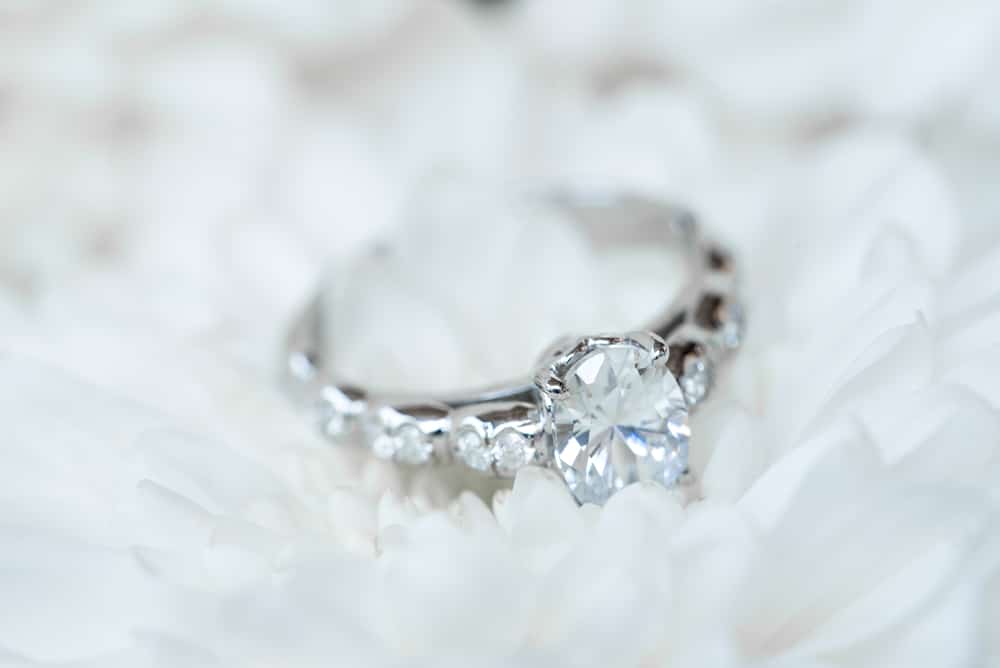
Here’s What You Will Learn
- Why do people like Oval Cut diamonds?
- Why is an oval cut diamond one of the most famous diamonds in history — and even now is ensconced at the center of the British Royal Family?
- What’s the difference between an Oval Cut and a Cushion Cut?
- What length / width ratio is best for an Oval Cut diamond?
- How can you choose an Oval Cut diamond, since the GIA doesn’t grade the Cut of any Fancy Shape diamond?
Why Do People Like Oval Cut Diamonds?
The main reason people are interested in Oval Cut diamonds for engagement rings may be that they are unique, compared to round brilliant diamonds, but not trendy.
Many couples like an engagement ring which stands out a little, but they don’t want to go full Art Deco by getting a step cut such as an Asscher Cut or an Emerald Cut, for example. An Oval Shape diamond is a perfect solution.
It even has the same number of facets as a Round Brilliant — 58. That maximizes its brilliance.
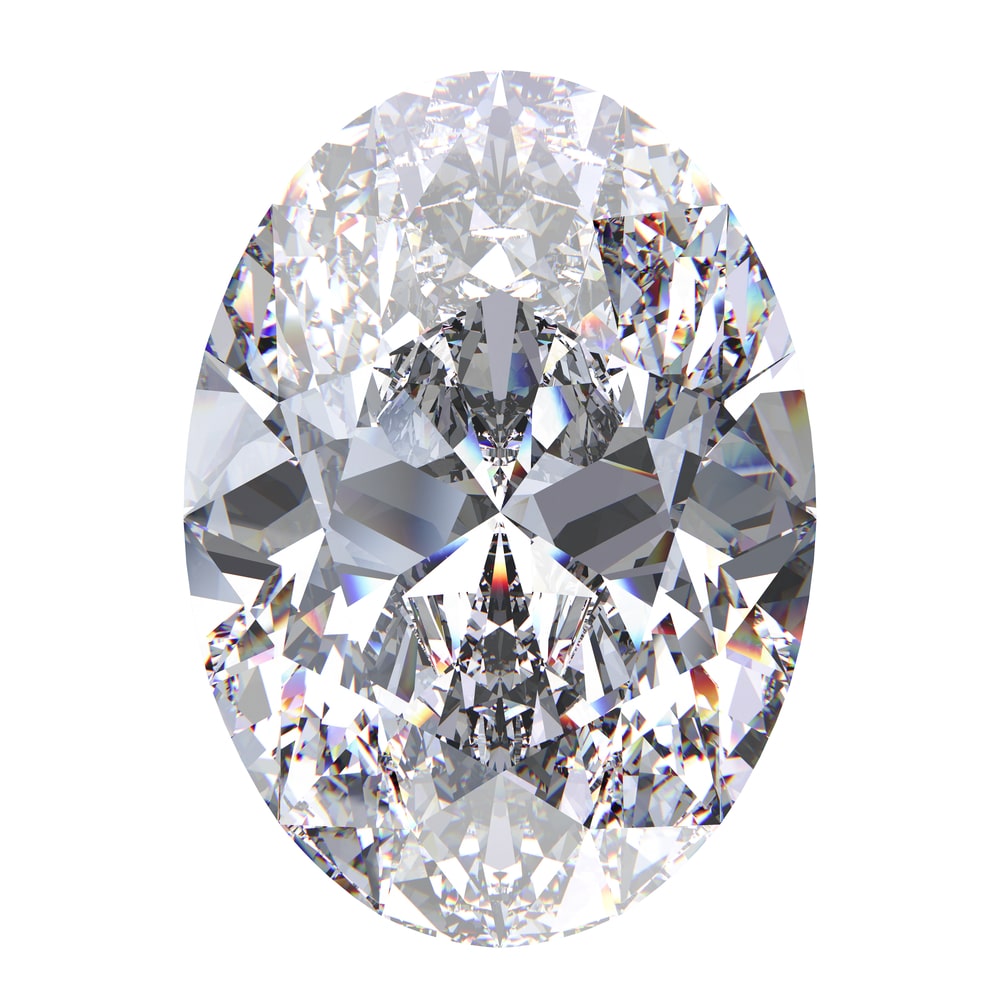
Oval Cut diamonds also complement any finger length. The length of short fingers seems to be enhanced, while long fingers are accentuated.
Oval Cut diamonds are less expensive than round brilliant diamonds.
They look larger than their carat size.
The slightly elongated shape offers more opportunities for various kinds of settings — flowing along the finger, flowing across the finger, or in custom settings at any angle of the dial.
What’s the Difference Between an Oval Cut and a Cushion Cut?
The best way to grasp the difference between an Oval Cut and a Cushion Cut is to compare two images (see the images below from James Allen).
You’ll notice immediately that the outline of the Oval is rounder and slightly elongated, while the Cushion Cut is more square and angular.
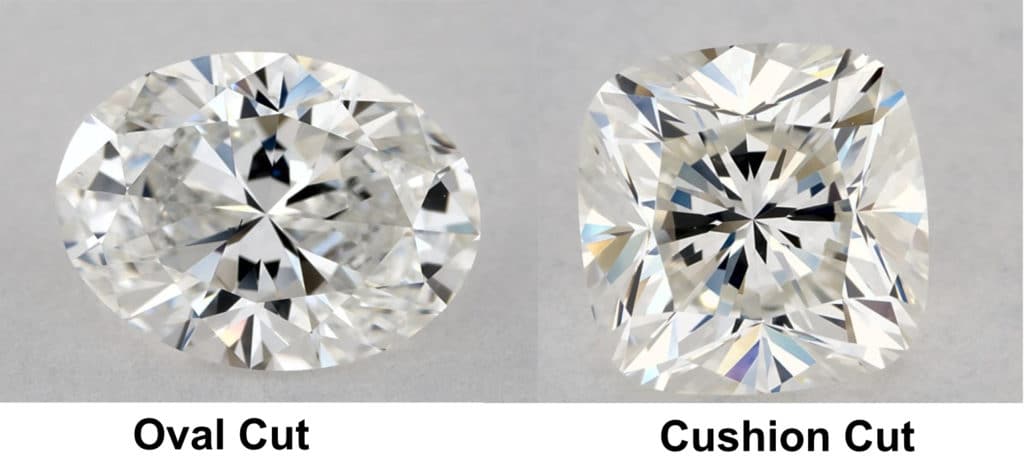
Which Is More Brilliant – Oval Cut or Cushion Cut?
All things being equal, a Cushion Cut is slightly more brilliant than an Oval Cut. That’s especially true of the “Crushed Ice” form of a Cushion Cut.
The differences in brilliance, however, depend on the individual diamonds — how well they’re cut. Any differences won’t be very noticeable unless compared side by side.
However, one thing will be noticeable, even from a distance. That is the larger appearance of an Oval Cut.
Which Appears Larger for the Same Carat Size – Oval Cut or Cushion Cut?
Because of its slightly elongated shape, and lesser depth, the Oval Cut presents more surface area to the eye, thus appearing larger.
That’s an attractive quality to many people, since size is the most noticeable difference in appearance in everyday life.
Which Stands out More – Oval Cut or Cushion Cut?
Most people would agree that the Oval Cut stands out more, since the Cushion Cut can appear almost round from a distance — much like the quite popular Round Brilliant Cut.
What’s the History of Oval Cut Diamonds? Are They New and Trendy? Classic? Conservative?
Oval Cut diamonds are newly popular, over the past few decades. (It makes sense to look at engagement ring trends in terms of generations, since they are — mostly — a once-in-a-lifetime purchase.)
So in that sense they are trending, in a good way, over generations.
But Oval Cut diamonds have been around for centuries. The most famous Oval Cut diamond of all time is the Koh-i-Noor, or “Mountain of Light” diamond.
Mined sometime between 1206 and 1500 near the south bank of the Krishna River in India, it weighed 186 Carats, changed hands between various kingdoms in various wars until it fell into the hands of the British in 1849.
In 1852 in London, this massive Oval Cut was recut to maximize its brilliance, receiving a total of 66 facets and dropping to 105.6 Carats. It ended up in the Queen Mother’s Crown, which is now on display in the Tower of London.
It’s literally one of the crown jewels of the royal family.
The modern Oval Cut was born in the late 1950s from the work of Lazare Kaplan, cousin to the famous diamond cut theorist Marcel Tolkowsky.
So the Oval Cut has been around for quite some time. It’s a classic cut, conservative but still adventurous, with roots in ancient India, the British Crown, and the Jewelers International Hall of Fame. It’s trending upward over generations but by no means “trendy.” You can wear this elegant cut with confidence and style.
Cut Quality – Depth and Proportions – of Oval Cut Diamonds
The GIA offers specific cut grading for Round Brilliant diamonds, but not for Fancy shapes. (Fancy shape diamonds are any diamond shapes other than Round.)
It’s worth mentioning quickly here that although we refer to Fancy shape diamonds as Oval Cut, Cushion Cut, Emerald Cut, etc., these terms are about shape.
The term “cut quality,” on the other hand, refers to the skill of the actually cutting.
“Cut quality” refers to:
- How well and skillfully the facets are shaped
- How well and skillfully the proportions are shaped
- How well and skillfully the symmetry is formed
Cut quality is important not only for the aesthetic form of the diamond. It’s also important for the way the diamond affects light that strikes it.
Cut Quality Determines the Brilliance and the Fire of a Diamond
- Brilliance: The amount of light the diamond reflects out through the top toward our eyes.
- Fire: The ability of the diamond to direct rainbow-like refractions of light through the top of the diamond.
How to maximize brilliance and fire in a Round Brilliant diamond is well-known. The precise depth of the diamond. The precise proportions. The number and placement of the facets.
But how to maximize brilliance and fire in Fancy shapes, including Oval Cut diamonds, isn’t nearly as well understood.
Your personal taste and observation, perhaps together with a diamond concierge, or other informed or experienced person, is the best way to judge the cut of an Oval Cut diamond.
Here Are Some Guidelines
I emphasize that these are only suggestions. There are no accepted, lab-created, scientific guidelines.
A well-proportioned Oval Cut might have (depending on your tastes and your experience of its brilliance and fire):
- A length to width ration of 1.3 to 1.5.
- A table percentage of 55% to 60%
- A depth percentage of around 59% to 62%
But these are just suggestions. The best way to judge cut quality of an Oval Cut diamond is to experience many Oval Cut diamonds virtually at James Allen or Blue Nile, or even in person.
What Is the Bowtie Effect and How Does It Concern Oval Cut Diamonds?
A bowtie effect can be seen by looking straight down through the table of an Oval Cut diamond. (It can also occur with other diamonds that are elongated along one axis.)
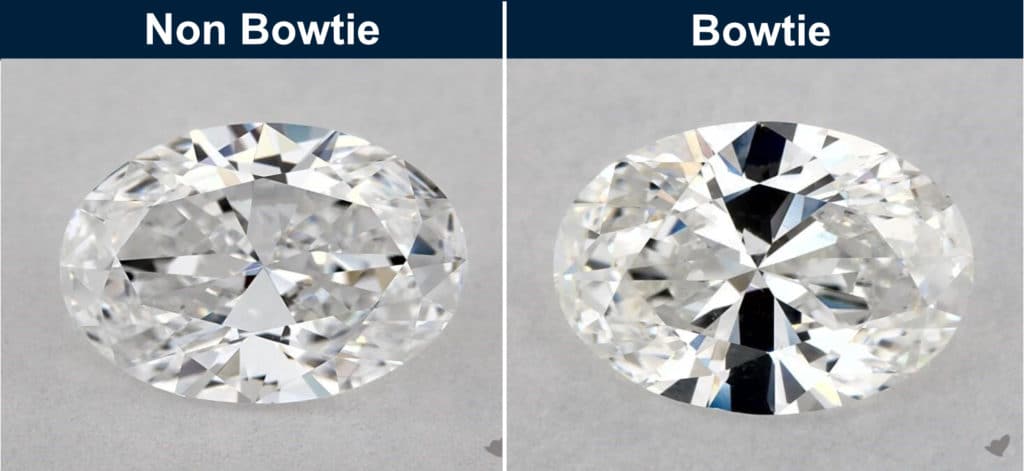
A small bowtie effect looks like a thin, almost invisible black line running the length of the short axis, ending at both sides in a V shape. Like a kid’s sketch of a bowtie.
A large bowtie effect looks thick and pudgy, and quite black. These are to be avoided. They can be connected by a thick line, or an almost invisible line. They can be just two disconnected V’s as well.
A strong bowtie effect is to be avoided.
The bowtie effect is a result of the same play of light which results in the prized “arrows” in the valued “hearts and arrows” effect.
To be clear, even though it involves the same physics as the prized “arrows”, a bowtie effect is always regarded as the mark of an inferior Oval Cut.
How to Choose Clarity in an Oval Cut diamond
Remember the GIA Clarity Grade Scale? (“Inclusions” means “flaws”.)
- IF – Internally Flawless
- VVS1 – Very Very Small Inclusions 1
- VVS2 – Very Very Small Inclusions 2
- VS1 – Very Small Inclusions 1
- VS2 – Very Small Inclusions 2
- SI1 – Small Inclusions 1
- SI2 – Small Inclusions 2
- I1 – Inclusions 1
- I2 – Inclusions 2
Unlike for example an Emerald Cut diamond, which reveals inclusions (flaws) openly, an Oval Cut diamond hides flaws quite well, due to its brilliance and the arrangement of the facets. In that way an Oval Cut is similar to a Round Brilliant Cut.
For this reason, for an engagement ring, you can choose an Oval Cut diamond with a below average technical Clarity score, for example SI1 and SI2.
You’ll save money, and not lose any visible clarity.
(All depends of course on the location of the inclusions inside the diamond. Or the location of any blemishes on the facets. Carefully observe any diamond to make sure that any inclusions or blemishes are not located in a highly visible spot. Usually, most inclusions in an Oval Cut diamond will be located in a spot not easily visible when the ring is worn.
At James Allen or Blue Nile, you can easily examine Oval Cut diamonds to see where the inclusions are. We recommend that you observe a diamond from above, looking for any inclusions visible through the table. If you can’t see them from above with the imagine technology of these two online retailers, then you won’t be able to see them when the diamond is worn in public.
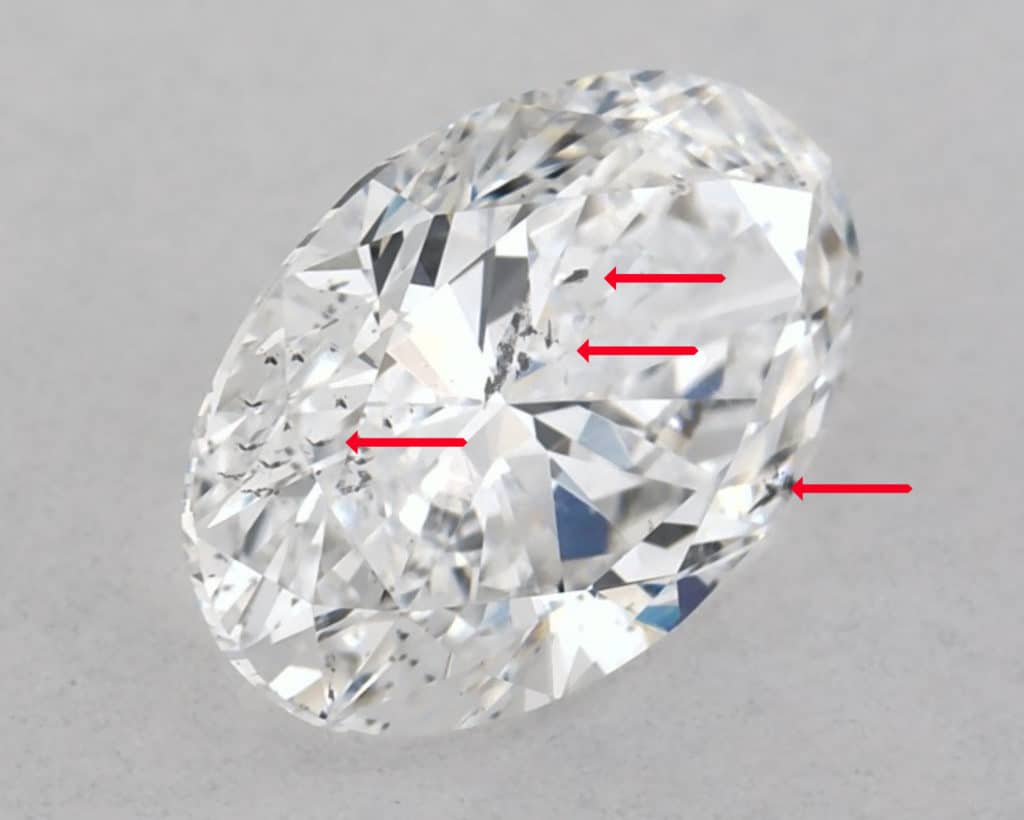
Color and Oval Cut Diamonds
The GIA, as you remember, grades colors on a scale from D (perfect) to Z.
Most jewelry retailers carry only diamonds of colors D through about M.
Diamonds of Color grades worse than M are so undesirable that they’re used in industry.
It’s difficult to see the differences in color unless you’re comparing two or more different color grades of diamonds.
That’s why it’s important to open two windows in your browser at James Allen, for example, and using the filters, select for different color grades of Oval Cut diamond. Compare many. Also compare how they look on various settings.
As you take the time to enjoy the pleasure of comparing diamonds’ colors, and comparing how the colors look on various settings, you’ll become an expert in those particular diamonds. You’ll be able to see what colors work well for you, and for the settings that you are considering.
Although it depends on you, your personal taste and observations, I think you’ll find that you can choose a color of F, G, or even H, and feel quite happy with it in an Oval Cut diamond.
The reason is that an Oval Cut diamond has enough brilliance that it can appear slightly more colorless than it really is.
Oval Cut Diamond Value
Oval Cut diamond prices can be a good 20% to 25% maximum under the prices of Round Brilliant Diamonds of the same Cut quality, Carat weight, Clarity, and Color.
Plus, Oval Cut diamonds appear larger.
Possible drawbacks to avoid include a large bowtie effect, and very slightly less brilliance.
You can browse scores of Oval Cuts right now…
Unlike some Fancy shapes (an Emerald Cut for example), I’m perfectly comfortable saying that you can surprise your beloved with an Oval Cut. It’s not too far out of the ordinary, expected, and safe choice of a Round Brilliant cut.
An Oval Cut is a beautiful, elegant, brilliant cut in its own right. It has connections to diamond cutting royalty in Lazare Kaplan, who invented the modern Oval Cut. It also has connections to actual royalty, as we’ve seen.
The Oval Cut is everything that has made the Round Brilliant Cut such a popular and beloved diamond.
It’s also everything that Fancy cut aficionados love about Fancy cuts: something a little different, distinctive, with connection to ancient lore and royalty.
As you shop for a diamond engagement ring, you can browse scores of stunning Oval Cut diamonds right now, at James Allen and Blue Nile. Begin your exploration. With this classy, affordable, prestigious cut, you’re likely to meet just the right diamond for your engagement ring in the selections you browse.
